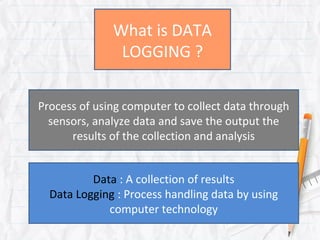Endothermic and exothermic process (1)
•Download as PPT, PDF•
0 likes•475 views
Data logging is the process of using computers to collect data through sensors, analyze the data, and save the results of the collection and analysis. It involves sensors that detect and record measurements, a data collector that receives information from the sensors, and data analysis to interpret the results. Common applications of data logging include monitoring industrial processes, scientific experiments, machine testing, and more.
Report
Share
Report
Share

Recommended
More Related Content
What's hot
What's hot (20)
Chapter17 section01 edit Flow of Heat Energy By Hamdy Karim.

Chapter17 section01 edit Flow of Heat Energy By Hamdy Karim.
Chapter17 section02 Measuring and Expresing Enthalpy Changes By Hamdy karim

Chapter17 section02 Measuring and Expresing Enthalpy Changes By Hamdy karim
Tang 01b enthalpy, entropy, and gibb's free energy

Tang 01b enthalpy, entropy, and gibb's free energy
Chem 2 - Chemical Kinetics VIII: The Arrhenius Equation, Activation Energy, a...

Chem 2 - Chemical Kinetics VIII: The Arrhenius Equation, Activation Energy, a...
Viewers also liked
Viewers also liked (20)
Motivation, culture and Learnings by Anna Oscarsson

Motivation, culture and Learnings by Anna Oscarsson
WordPress, migrazioni e re-branding: don't try this at home. #wmf15

WordPress, migrazioni e re-branding: don't try this at home. #wmf15
Operational and Development Overview of Polio Plus presentation

Operational and Development Overview of Polio Plus presentation
Similar to Endothermic and exothermic process (1)
Similar to Endothermic and exothermic process (1) (20)
Chemistry_Energetics_Lecture_1.Chemistry_Energetics_Lecture

Chemistry_Energetics_Lecture_1.Chemistry_Energetics_Lecture
Notes for Unit 17 of AP Chemistry (Thermodynamics)

Notes for Unit 17 of AP Chemistry (Thermodynamics)
Endothermic and exothermic process (1)
- 1. What is DATA LOGGING ? Process of using computer to collect data through sensors, analyze data and save the output the results of the collection and analysis Data : A collection of results Data Logging : Process handling data by using computer technology
- 2. ELEMENTS OF DATA LOGGING
- 4. Endothermic and exothermic process
- 5. engage a b
- 7. Empower Sensor Data collector
- 9. Result Solution of copper (II) sulphate,
- 11. Solution of anhydrous copper (II) sulphate
- 13. • Is the enthalpy change for this reaction exothermic or endothermic? • What sign should the enthalpy change have? • What is the equation for this reaction? • What bonds are being broken and formed in this reaction? • What is this enthalpy change called?
- 14. • How can we make a triangle between these reactions?
- 15. Enhance Cold packs and putting ice in towel causes a cooling effect on their person’s head and temporarily relieve the pain and fever. Explain.
- 16. a) Cold Pack • When the cold pack is used, the chemicals inside the pack are made to react with each other and this reaction is highly endothermic in nature. • Endothermic reactions involve the absorption of heat.
- 17. • The ammonium nitrate mixing with the water creates cold. The temperature of cold packs can reach back to normal temperature. • The heat energy is taken into the system from the surrounding. The surrounding in this case is the person’s head.
- 18. Extension Production of Ammonia Gas : N2 (g) + 3H2 (g) ↔ 2NH3 (g) What will happen to the reaction if we increase the concentration the temperature of the reactant mixture?
- 19. • If the temperature of a reaction mixture is increase, the equilibrium will shift to decrease the temperature. • Based on Le Chatelier’s Principle which stated that if a chemical system at equilibrium experiences a change in concentration, temperature or total pressure, the equilibrium will shift in order to minimize that changes a new equilibrium is established.
- 20. • So, if we increase the temperature, the equilibrium will shift to the reactant part which is left. • So, the reaction will undergo endothermic reaction as it use up heat energy. • Ammonia will broken down into hydrogen and nitrogen gas. An increase in temperature will decrease the yield of ammonia , NH3.
